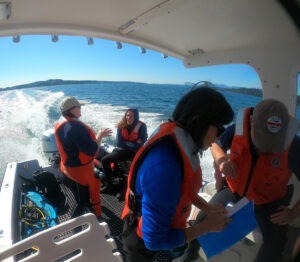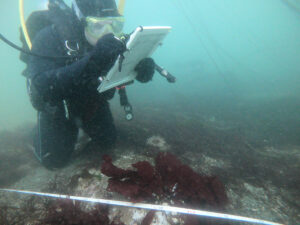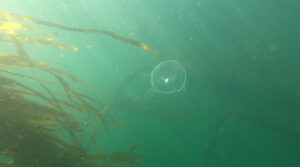An underwater crisis is happening, and there isn’t one apparent reason. Since the 1870s, South Puget Sound’s shorelines have lost about two-thirds of their bull kelp forests, according to a study by the Washington Department of Natural Resources.
A towering seaweed, kelp provides food and shelter for otters, invertebrates, and over 100 fish species. It can live for many years, with some species growing up to 18 inches daily and forming forests over 150 feet tall. Bull kelp is an annual seaweed, meaning it dies and grows back every year.
Point Defiance Zoo’s Dive Safety Officer Gavin doesn’t need a study to tell him what he’s been seeing for the past several years in Puget Sound.
“The loss of our local kelp forests has accelerated quickly, and it’s alarming,” said Gavin. “Entire underwater forests are in danger of being wiped out.”

Divers from Point Defiance Zoo are working hard to help find some answers. This past August and September, when kelp was at its highest, they dove six times in local waters to survey the entire ecosystem of a bull kelp forest.
On a Monday morning in September, they lowered themselves into the water near Foulweather Bluff Preserve, at the head of the Salish Sea near the Admiralty Inlet. Divers carried lots of gear, transect tape, a camera, dive lights, and a waterproof data sheet and pencil.
“The method used involves a total of over 20 individual surveys at each site we visit,” explained Gavin. “We record the species and number of kelp plants we see and count every fish and algae species along with documenting the substrate and topography of the site.”
The diver’s data ultimately helps create a map of what’s going well and what isn’t in the kelp forest of Puget Sound. Researchers can hopefully then find patterns and pressures affecting these critical forests’ health.
“It’s too early to tell, but there are strong indications that rising water temperatures, sewage and development runoff, and damage caused by boats are a few of the many possible reasons kelp is declining,” said Gavin.

But at sites like Foulweather Bluff, where the forest is still healthy, the dive team looks for essential indicators of an ecosystem in balance, like the amount of “young-of-year” (under one year of age) rockfish. In total, the divers look for over 70 species of kelp, fish, and invertebrates on each survey.
“Kelp provides critical feeding and nursery grounds for rockfish and salmon,” said Gavin. “It also helps support even bigger predators, like Southern Resident killer whales, in the food web.”
A healthy kelp forest depends on a healthy food chain. Kelp forests raise oxygen levels, improving water conditions and helping all sea life flourish.
“These forests benefit all underwater life forms,” said Dive Safety Officer Heidi. “It’s essential we protect the biodiversity of coastal marine ecosystems.”
The results of each kelp survey are compiled into a shared database with other agencies, like the Washington Department of Fish and Wildlife, the National Oceanic and Atmospheric Association, and the Washington Department of Natural Resources.

“Monitoring what is happening in these underwater kelp sites will help us increase public awareness and the development of effective conservation policy,” said Heidi.
Point Defiance Zoo is partnering on the kelp monitoring effort with the Puget Sound Restoration Fund and many other non-profit, tribal, and government organizations.
“This is a multi-year initiative and a collective group effort,” said Heidi. There is a lot of attention on this crisis right now, and we cannot save these species fast enough.”
Learn more about the Puget Sound Kelp Conservation and Recovery Plan to protect and restore the kelp forests of Puget Sound.